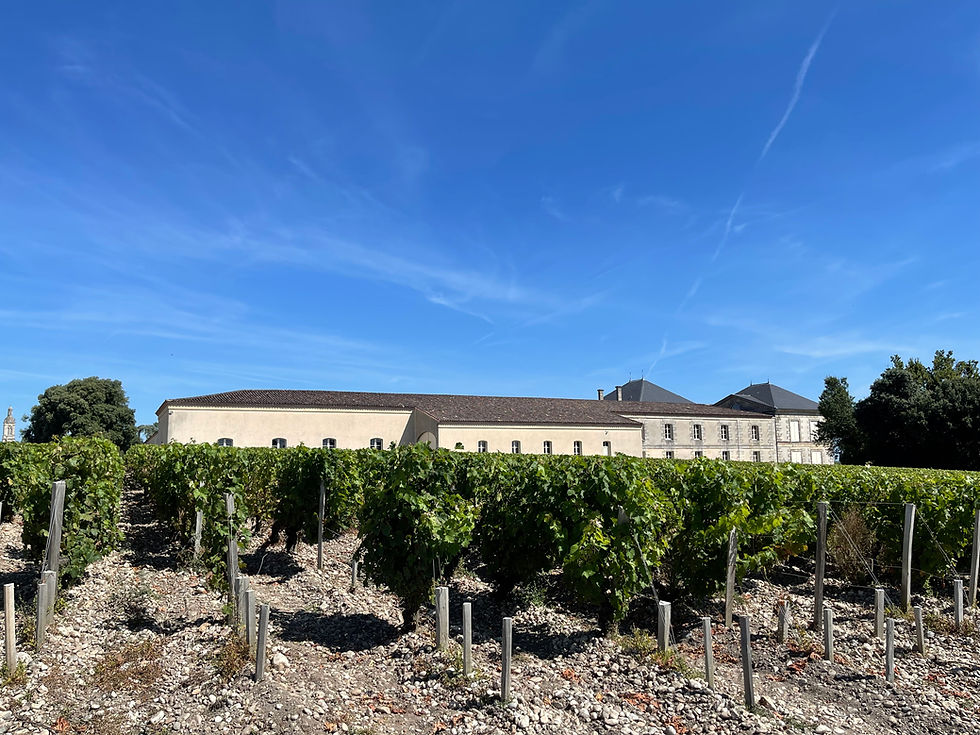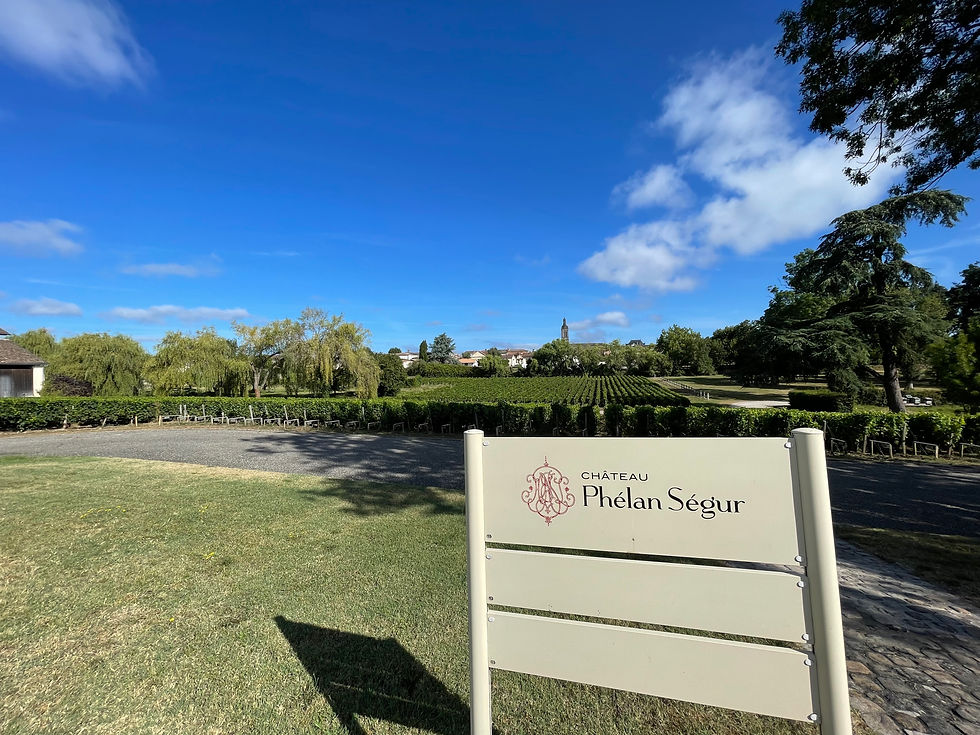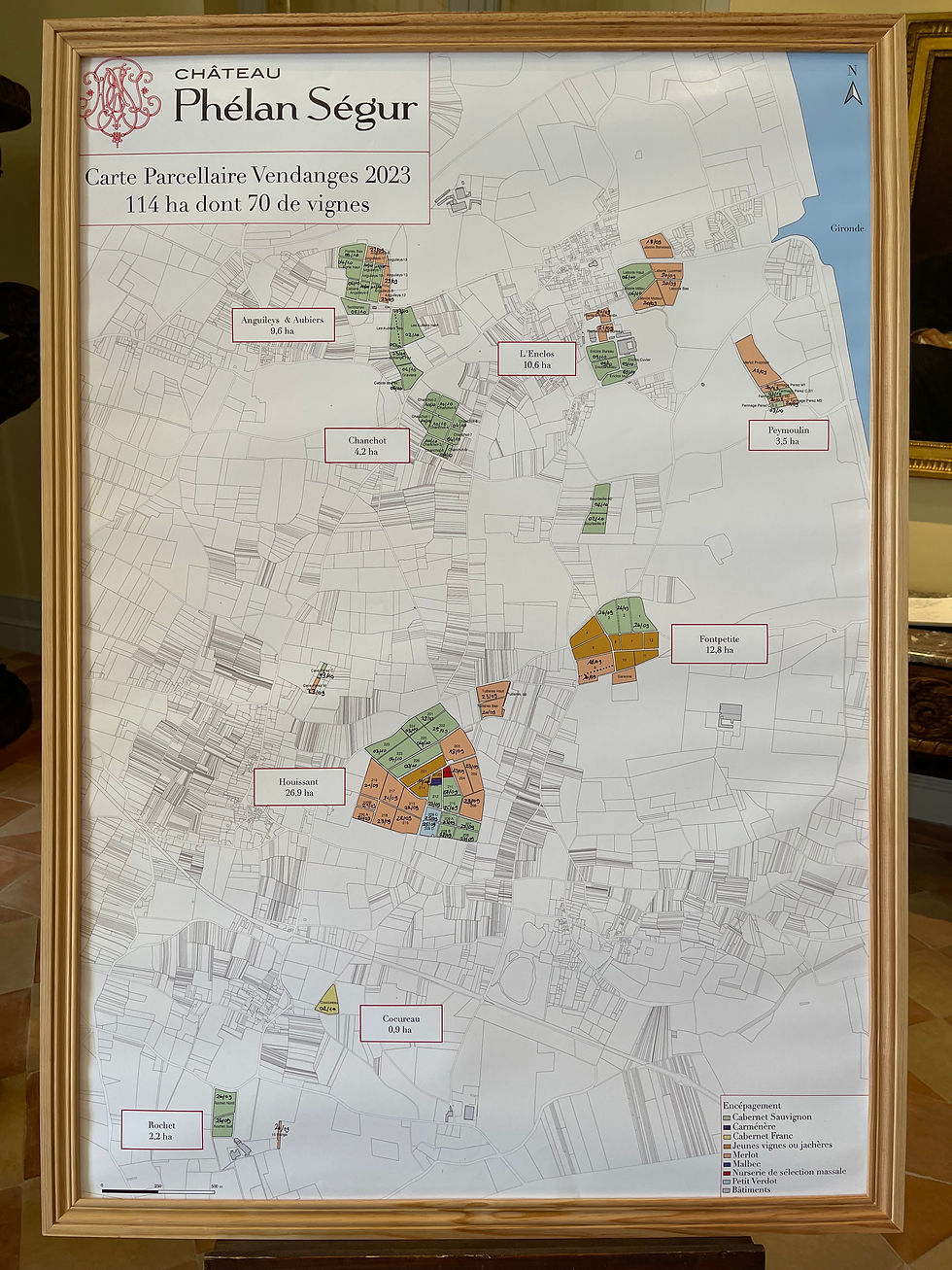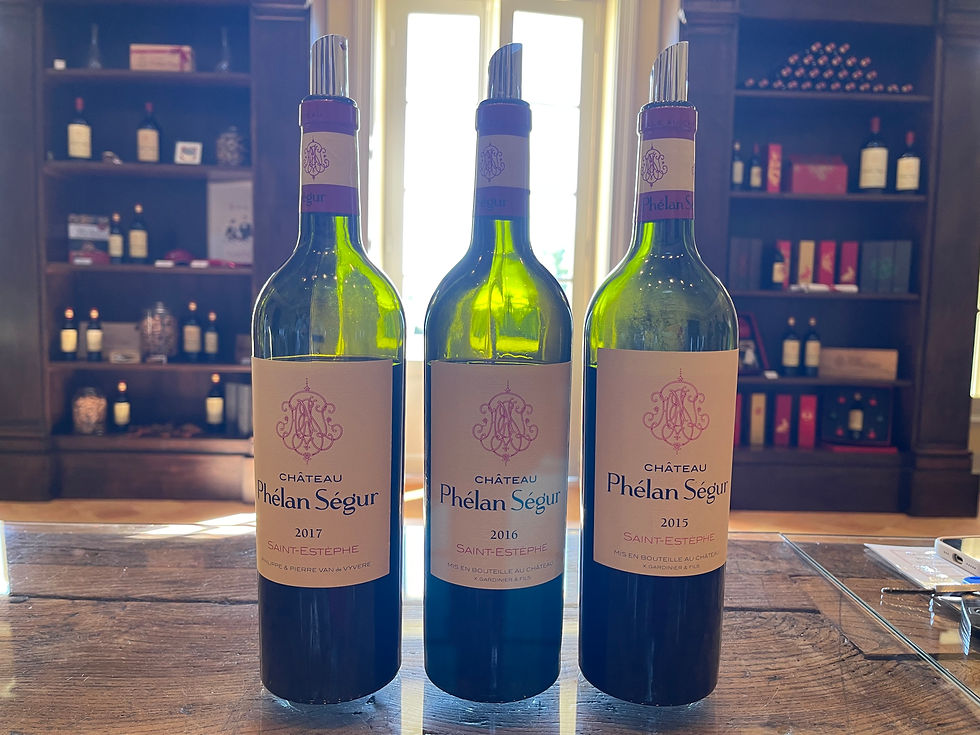Château Phélan Ségur ‒ A Blend of Irish Heritage and Bordeaux Tradition
- Song Wei

- Sep 9, 2024
- 7 min read
As I approached Château Phélan Ségur, the excitement was palpable. Driving through the entrance gates, I was immediately immersed in the estate's expansive beauty. The path meandered through a vast, meticulously maintained garden, each turn revealing more of the chateau’s architectural splendour. As I passed the striking facade of the château itself, I felt a sense of anticipation build, culminating in my arrival at the welcoming reception office. The journey through the estate set the stage for an extraordinary exploration of one of Bordeaux's most distinguished properties.


The story of Château Phélan Ségur begins not in France, but in Ireland, setting it apart from many other Bordeaux estates. Bernard O’Phelan (1770-1841), a young Irish wine merchant from Tipperary, ventured to Bordeaux at the end of the 18th century, drawn by the town’s prominence as a trading hub with the British Isles. Bordeaux’s vibrant wine trade fostered close relationships among families who bought and sold wines, leading to alliances and marriages. Bernard Phélan married a daughter of Daniel Guestier, a well-known Bordeaux wine merchant. With his father-in-law’s experience, Bernard envisioned producing his own wines.
In 1805, Bernard acquired Clos de Garramey in Saint-Estèphe and later, in 1810, he added the Ségur de Cabanac estate to his holdings. Building on this foundation, the Phélan family introduced an innovative architectural legacy. At the heart of a park in Saint-Estèphe, Château Phélan Ségur stands out not only for its Palladian-style architecture but also for its innovative design. Unlike the architectural norms of the time, which typically separated the mansion from production areas, the Phélan family integrated the vat room and cellar within the château. This pioneering approach created one of the first "Médoc-style" vat rooms, emphasising the château’s commitment to wine production.
Upon Bernard Phélan’s death in 1841, his son Frank Phélan (1820-1883) inherited the estate, then known as Château Ségur de Garramey. Frank, a dedicated Médocain despite his Irish roots, devoted his life to enhancing the estate's reputation and wine quality. He also served as the mayor of Saint-Estèphe for thirty years and was an active figure in the Irish community in Bordeaux, which included families such as Johnston, Barton, Clarke, and Lynch. In the early 20th century, Château Ségur de Garramey adopted its modern name, Château Phélan Ségur, symbolising a blend of classic values, innovation, and heritage.

The château transitioned through several owners before becoming the property of Xavier Gardinier in 1985. Alongside his sons, Xavier Gardinier embarked on extensive restoration efforts to restore the estate to its former glory. Notably, under their stewardship, the château was once classified as a Cru Bourgeois, but they chose to withdraw from the classification in 2018 to better focus on their distinctive vision and quality. After over three decades of dedicated stewardship, the Gardinier family handed over the reins to Philippe Van de Vyvere, a dedicated wine enthusiast. For Philippe, acquiring Château Phélan Ségur represents the realisation of a lifelong dream, continuing the legacy of excellence and tradition established by his predecessors.
My guided tour started with a stroll across the vineyard. The vineyard of Château Phélan Ségur spans 70 hectares of exceptional clay-gravel soils on the hillocks and plateaux of Saint-Estèphe. This terroir, distinguished by its unique composition and advantageous location, plays a crucial role in producing high-quality wines. Divided into four large sections, the parcels of Château Phélan Ségur's vineyard adjoin the renowned vineyards of Châteaux Montrose and Calon Ségur. The high planting density contributes to the vineyard's productivity and quality.

The vineyard features a diverse blend of grape varieties: 58% Cabernet Sauvignon, 39% Merlot, and 1.5% each of Cabernet Franc and Petit Verdot. Cabernet Sauvignon, often hailed as the king of Médoc grape varieties, imparts unparalleled power and structure to the Grand Vin, serving as its backbone. Merlot adds an attractive roundness and supple texture to the wines. Petit Verdot, introduced to the vineyard in 2015, thrives on the heavier, clay-dominated soils, adding a hint of spice to the blend. This variety requires meticulous care but excels in bringing complexity to the wine. Cabernet Franc, a long-standing component of the vineyard, contributes finesse and floral notes, enhancing the overall blend.

The terroir of Château Phélan Ségur exemplifies the complexity and richness of Saint-Estèphe, with its diverse soil composition enhancing the quality of its wines. The estate's soils include humus-rich gravels at the summit of the Fontpetite parcel, clay gravels at Chanchot, and sandy gravels on the middle slopes of Fontpetite. This varied soil profile, shaped by centuries of gravel deposits and clay-coated sands, contributes to a rolling landscape that allows for a diverse expression of grape characteristics, adding depth and complexity to the wines. The proximity of the vines to the Gironde estuary offers a unique advantage. The maritime climate of the Médoc, characterised by a well-marked seasonal cycle, supports the annual growth of the vine while mitigating extreme weather conditions. The estuary helps protect the vineyard from harsh winters and overly hot summers, ensuring a stable growing environment.
The vineyard work at Château Phélan Ségur in Saint-Estèphe embodies a deep respect for both the land and the art of winemaking. Vineyard Manager Stéphane Rougé, with his commitment to responsible viticulture, carefully interprets the estate’s distinctive terroir. Since his arrival, Rougé has championed environmentally conscious practices, emphasising the importance of soil health and plant vitality. He meticulously studies the subsoils, adapts grape varieties and rootstocks, and experiments with vine exposure to ensure the flourishing of young vines and the health of mature plants.
The estate prioritises sustainable viticulture, with vineyards ploughed to minimise herbicide use and others grassed over to control vigour and reduce leaching. Organic fertilisation practices are employed, and biodiversity is preserved. Advances in agronomy are integrated into vineyard management, including innovative prophylactic methods to reduce the reliance on plant protection products. Techniques such as strategic pruning, adapted trellising, and controlled leaf removal help manage vine health and productivity.
A key technological advancement at Phélan Ségur is the Greenseeker technology, a cutting-edge system that measures and interprets vine vigour throughout the year. This technology, which includes a GPS-connected system installed on straddle tractors, calculates the NDVI (Normalised Difference Vegetation Index) to assess plant physiological activity. The data gathered helps optimise fertilisation and treatments, and informs decisions on pruning and leaf removal, contributing to precise vineyard management. Since its introduction, the Greenseeker technology has facilitated the determination of micro-plots with uniform vigour, influencing decisions on grape vatting and supporting an ongoing environmental strategy. The estate's commitment to reducing inputs aligns with the Ecophyto 2018 objective, using biotechnical methods like sexual confusion with pheromone tags to manage pests and minimise pesticide use.

The Phélan Ségur team, led by Rougé, is dedicated to preserving traditional skills while embracing modern innovations. The expertise of veteran winegrowers is passed down to the younger generation, ensuring the precision of vital practices such as pruning. Despite the uncertainties of weather conditions, which can threaten the harvest, the team’s dedication culminates in a carefully managed manual harvest by a dedicated crew of pickers, bringing the fruits of a year's labour to fruition.
Next, I visited the vat room. One of the most exciting recent developments in their winemaking process is the introduction of wild yeast fermentation, a method they began employing in 2020. This innovative approach, aimed at expressing the unique characteristics of each vintage, sets them apart in the Médoc region. Unlike commercial yeast, wild yeast is naturally present on the grape skins and in the environment, contributing to a more authentic and complex flavour profile. First step of this process begins two weeks before the official harvest start date. Expert vintners hand-pick 2 kilograms of grapes and bring them to the lab for micro-fermentation. This initial micro-fermentation, utilising the wild yeast on the grape skins, serves as a test to ensure the yeast's viability and effectiveness. A “cream of yeast” is produced for each plot. It ensures that each batch of wine has a distinct and consistent fermentation profile, reflecting the unique characteristics of the specific vineyard plots. Currently, two-thirds of Château Phélan Ségur's production is crafted using wild yeast, a testament to their commitment to this method. Remarkably, they are the only chateau in the Médoc region to employ this fermentation technique, highlighting their pioneering spirit and dedication to excellence.

To further enhance their winemaking process, Château Phélan Ségur collaborates with renowned oenologist Michel Rolland. His expertise and innovative approach have been instrumental in refining their techniques and achieving outstanding results. Under his guidance, the chateau has been able to navigate the complexities of wild yeast fermentation and integrate it seamlessly into their production process.
Then, I visited the ageing cellar. As the door first opened, I was greeted by the sight of rows upon rows of barrels neatly stacked, each contributing to the cellar's serene and orderly ambiance. Their grand vin is aged in a combination of 55% new French oak and 45% used French oak barrels, creating a balanced and complex profile. In contrast, their second wine is aged in 10% new French oak and 90% used French oak, allowing for a more subtle oak influence. The barrels are used for up to two vintages before being sold to other merchants who produce spirits like whisky or Armagnac. They are medium to medium-(+) toasted. The chateau collaborates with six different coopers, each bringing their unique expertise to the barrel-making process.

Finally, the guided tour concluded with a tasting session in the elegant tasting room. The session began with a vertical tasting of the grand vin Château Phélan Ségur, sampling the 2015, 2016, and 2017 vintages. Starting with the 2017 vintage, a cold and challenging year, the wine displayed a blend that included Cabernet Franc. It had higher acidity and offered notes of red fruits and red flowers, with a light structure and body, making it ready to drink now. Next, we tasted the 2016 vintage, which came from a year with the perfect combination of rain and warmth. This wine had more pronounced oakiness, darker fruit flavours, and higher tannins. It needed to be decanted before serving and has the potential to age further for another 3-5 years. Lastly, I sampled the 2015 vintage, an exceptional year for the vineyard. This wine showed a slightly browner colour, was more elegant, and had prominent tobacco aromas along with higher tannins, giving it the potential to age further for 7-10 years, making it a standout in the tasting lineup.

As my visit to Château Phélan Ségur drew to a close, it was clear that the estate represents more than just a wine producer; it is a harmonious blend of tradition and innovation, reflecting both its rich Irish heritage and its deep Bordeaux roots. The guided tour and tasting session offered a profound appreciation for the meticulous craftsmanship and passionate dedication that define this remarkable property. Leaving behind the serene beauty of the château and its vineyards, I carried with me a newfound admiration for Château Phélan Ségur’s commitment to excellence and its enduring legacy in the world of fine wine.








Comments